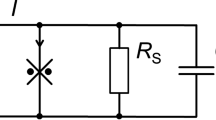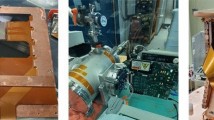Abstract
This paper reports our results on the electrothermal modeling of cryogenic silicon bolometers with pixel pitches of 500 and 1200 µm designed for cosmic microwave background polarimetric observation in 0.6 mm and 1.5 mm bands. These detectors should provide a high responsivity, typically around 1011 V/W, and a very low noise equivalent power (NEP) of 10−18 W/Hz1/2 between 50 and 100 mK. They are based on doped silicon thermometers, which exhibit a nonohmic behavior described by the “hot electron model” (HEM) at very low temperature under high bias currents. We compare this model to the experimental characterization of these thermometers at cryogenic temperatures to confirm that the HEM is governing their electrical characteristics and their sensitivity at very low temperature. Finally, this model is used to derive the simulated responsivity and NEP performances of the pixels under weak and moderate optical power illumination.





Similar content being viewed by others
Notes
In the VRH regime, the conduction results from localized states in a narrow band around the Fermi level. For an intermediate compensation (K = Na/Nd ~ 0.5), there is no region close to the Fermi level where the density of states is constant because the Coulomb gap is maximum. Consequently, at low enough temperature, which is activating the hopping process, the effect of the Coulomb gap is noticeable: there is no region where γ = ¼ (Mott model) [5].
References
K.L. Denis, A. Ali, J. Appel, C.L. Bennett, M.P. Chang, D.T. Chuss, F.A. Colazo, N. Costen, T. Essinger-Hileman, R. Hu, T. Marriage, K. Rostem, K. U-Yen, E.J. Wollack, J Low Temp Phys 184, 668–673 (2016). https://doi.org/10.1007/s10909-015-1366-y
L. Rodriguez, A. Poglitsch, A. Aliane, J. Martignac, D. Dubreuil, L. Dussopt, V. Revéret, V. Goudon, S. Bounissou, O.-A. Adami, C. Delisle, O. Gevin, X. De La Broise, B. Maffei, J.-L. Sauvageot, J. Low Temp. Phys. 193, 449–454 (2018). https://doi.org/10.1007/s10909-018-2000-6
A. Aliane, M. Solana, W. Rabaud, L. Saminadayar, P. Agnese, V. Goudon, L. Dussopt, C. Vialle, E. Baghe, S. Pocas, L. Carle, N. Lio Soon Shun, S. Becker, V. Reveret, L. Rodriguez, A. Hamelin, A. Poglitsch, S. Bounissou, O. Adami, J Low Temp Phys 193, 655–660 (2018). https://doi.org/10.1007/s10909-018-1919-y
V. Goudon, A. Aliane, W. Rabaud, C. Vialle, S. Pocas, E. Baghe, L. Dussopt, P. Agnese, N. Lio Soon Shun, S. Becker, V. Reveret, J.L. Sauvageot, L. Rodriguez, M. Solana, Saminadayar L. Nucl. Instrum. Methods A 912, 78–81 (2018). https://doi.org/10.1016/j.nima.2017.10.057
A.L. Efros, B.I. Shklovskii, J. Phys. C 8, L49 (1975). https://doi.org/10.1088/0022-3719/8/4/003
M. Galeazzi, D. Liu, D. McCammon et al., Phys. Rev. B76, 155207 (2007). https://doi.org/10.1103/PhysRevB.76.155207
O.-A. Adami, L. Rodriguez, A. Poglitsch, S. Bounissou, V. Reveret, A. Aliane, V. Goudon, L. Dussopt, Appl. Opt. 58, 398–403 (2019). https://doi.org/10.1364/AO.58.000398
A. Aliane, J-L. Sauvageot, X. De La Broïse, C. Pigot, J. Martignac, E. Grémion, V. Szeflinski, J. Goupy, P. Agnese, in SPIE Proceedingd, vo, 7732, Article number 77321O, (2010). Doi: https://doi.org/10.1117/12.856878
P.M. Downey, A.D. Jeffries, S.S. Meyer, R. Weiss, F.J. Bachner, J.P. Donnelly, W.T. Lindley, R.W. Mountain, D.J. Silversmith, Appl. Opt. 23, 910–914 (1984)
O.-A. Adami, L. Rodriguez, V. Reveret, A. Aliane, A. Poglitsch, J.-L. Sauvageot, S. Bounissou, V. Goudon, L. Dussopt, J. Low Temp. Phys. 193, 415–421 (2018). https://doi.org/10.1007/s10909-018-1993-1
Acknowledgements
The authors would like to thank A. Charpentier, O. Girard, P. Sixt, N. Bernard-Henriques from CEA-TECH (Grenoble, France) for their help during the samples fabrication. This work has been partially supported by the LabEx FOCUS ANR-11-LABX-0013.
Author information
Authors and Affiliations
Corresponding author
Additional information
Publisher's Note
Springer Nature remains neutral with regard to jurisdictional claims in published maps and institutional affiliations.
Rights and permissions
About this article
Cite this article
Aliane, A., Adami, OA., Dussopt, L. et al. Design, Simulation and Fabrication of Highly Sensitive Cooled Silicon Bolometers for Millimeter-Wave Detection. J Low Temp Phys 199, 56–64 (2020). https://doi.org/10.1007/s10909-020-02405-6
Received:
Accepted:
Published:
Issue Date:
DOI: https://doi.org/10.1007/s10909-020-02405-6




